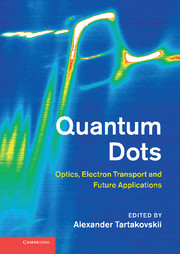Book contents
- Frontmatter
- Contents
- List of contributors
- Preface
- Part I Nanostructure design and structural properties of epitaxially grown quantum dots and nanowires
- Part II Manipulation of individual quantum states in quantum dots using optical techniques
- 4 Studies of the hole spin in self-assembled quantum dots using optical techniques
- 5 Resonance fluorescence from a single quantum dot
- 6 Coherent control of quantum dot excitons using ultra-fast optical techniques: the role of acoustic phonons
- 7 Holes in quantum dot molecules: structure, symmetry, and spin
- Part III Optical properties of quantum dots in photonic cavities and plasmon-coupled dots
- Part IV Quantum dot nano-laboratory: magnetic ions and nuclear spins in a dot
- Part V Electron transport in quantum dots fabricated by lithographic techniques from III–V semiconductors and graphene
- Part VI Single dots for future telecommunications applications
- Index
- References
6 - Coherent control of quantum dot excitons using ultra-fast optical techniques: the role of acoustic phonons
from Part II - Manipulation of individual quantum states in quantum dots using optical techniques
Published online by Cambridge University Press: 05 August 2012
- Frontmatter
- Contents
- List of contributors
- Preface
- Part I Nanostructure design and structural properties of epitaxially grown quantum dots and nanowires
- Part II Manipulation of individual quantum states in quantum dots using optical techniques
- 4 Studies of the hole spin in self-assembled quantum dots using optical techniques
- 5 Resonance fluorescence from a single quantum dot
- 6 Coherent control of quantum dot excitons using ultra-fast optical techniques: the role of acoustic phonons
- 7 Holes in quantum dot molecules: structure, symmetry, and spin
- Part III Optical properties of quantum dots in photonic cavities and plasmon-coupled dots
- Part IV Quantum dot nano-laboratory: magnetic ions and nuclear spins in a dot
- Part V Electron transport in quantum dots fabricated by lithographic techniques from III–V semiconductors and graphene
- Part VI Single dots for future telecommunications applications
- Index
- References
Summary
Introduction
Quantum dots are often referred to as artificial atoms, since they trap carriers in discrete energy-levels due to the nanoscale three-dimensional finite potential energy well they provide. As such, dots exhibit a coherent light–matter interaction that is similar to an atom. This is evidenced by observations of atom–optics phenomena such as Rabi oscillations [43, 26], power broadening [27], Autler–Townes doublet [14, 42], Mollow triplet [42, 8], and coherent population trapping [6]. In this chapter, Rabi rotation measurements are used to examine how an exciton transition deviates from an ideal two-level atom due to its interaction with a reservoir of phonons.
The neutral exciton transition may be regarded as a two-level system, or qubit, composed of the crystal ground-state ∣0〉 and a single electron-hole pair ∣X〉. The state-vector of a qubit can be described as a pseudo spin-half. When an oscillating electro-magnetic field resonantly excites the two-level transition it drives an oscillation in the population inversion known as a Rabi oscillation. This results from the oscillations of the driving field and the dipole of the two-level system being synchronous, such that in its rotating frame, the driving field acts as a static magnetic field that causes the pseudo-spin to rotate. Coherent control of the pseudo-spin can be achieved by applying well-defined driving fields, enabling the preparation, and manipulation of superposition states. Such coherent control concepts have found widespread use in electron spin, and nuclear magnetic resonance spectroscopy.
- Type
- Chapter
- Information
- Quantum DotsOptics, Electron Transport and Future Applications, pp. 103 - 117Publisher: Cambridge University PressPrint publication year: 2012



